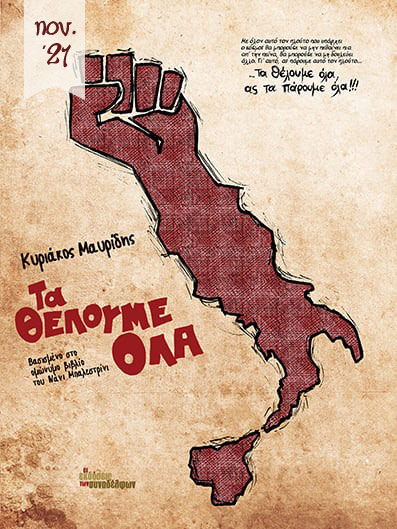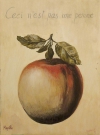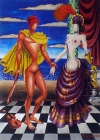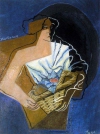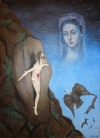Displaying items by tag: tempera
This is a small reproduction of the painting Ceci n'est pas une pomme, by Rene Magritte. It was made with temperas (which resulted to a less saturated version of the image)
These two works are reproductions of paintings by the cubist painter Juan Gris. The woman with the basket (1927) is made with tempera (40 x 30cm) while Bottle and Fruit Dish (π.35 x 45cm) and Water bottle, Bottle and Fruit Dish (1915) with oil colors (1m x 70 cm). Both paintings were made before 2004.
Copies of Dali's paintings I made mostly during 2002. I used tempera and two of them (the nurse and girl at the window) I placed them on a self -made frame. In three of them there are some minor (or not so minor) changes made deliberately. The original paintings are: The Basket of Bread (1926), Christ of Saint John of the Cross (1951), Crucifixion (Corpus Hypercubus, 1954), Mysterious Mouth Appearing in the Back of My Nurse (1941), The Elephants (1948), Figure at a window (1925), The Burning Giraffe (1937).
Copies of paintings by El Greco. The two bigger ones ( The Agony in the Garden of Gethsemane, 1590 (50x60cm) and St. Francis (50x70cm) ) are made with oil colors (on canvas and paper respectively) while the three smaller ones (size approx. 30x40cm) were made with tempera on paper.
Agony in the Garden
Realism gives way to the opposite extreme in this fantastic vision of a Spanish mystic. Figures and landscape are distorted, far removed from nature in shape, lighting, color and texture. But unlike ordinary dream pictures, it is organized, consistently directed to a purpose, not a mere extravagant jumble. As representation, it gives clearly enough the essentials of a story that was familiar and moving in the intensely religious age of the Inquisition. But of greater interest now is the striking design of diagonal planes and vivid colors. In composition it is one of the latest of several different treatments of this theme, in which Greco sought more and more compression and simplification, the gathering together of scattered parts, the bringing out of main features with greater emphasis. In earlier versions, for example, the sleeping disciples were large, nearby and comparatively detached from the rest of the design. Here Christ and the angel are large and bold, in slashing angular strokes, while around them swirl twisting ovals of cloud. Smaller parts echo the diagonal swirling and crisscross motion of the larger ones. The painting is all in terms of pure color, not of light and line with color added on the surface. Again in contrast with the sombre Van Eyck, it flares with a lurid phosphorescent glow of changing colors, crimson, blue-green and golden yellow. Their clashing excitement is in harmony with the rhythm of movement, and with the general spirit of ecstatic drama. (info by oldandsold.com)
Christ kneels in the centre; at the upper left an angel appears to him with a cup, a reference to his forthcoming Passion. In the background on the left are the sleeping apostles - Peter, James the Greater and John; on the right Judas approaches with soldiers.
The painting is a synthesis of varying accounts of the Agony in the Gospels and is probably a workshop replica of a painting in the Museum of Toledo (Ohio). There are also several authentic vertical versions of this composition.
(Info by nationalgallery.org.uk)
Now in Bookstores
We Want Everything
the publications of colleagues, Nov. 2021
Summer of 1969, Italy. A year after May '68, FIAT workers began a dynamic and unmediated strike against their powerful boss. Their struggle marked the beginning of a decade of workers' and students' mobilizations and the rise of the Autonomy movement. It was characterized by many as the last invasion of the working class into the sky. Last ... let's hope until the next one ...
